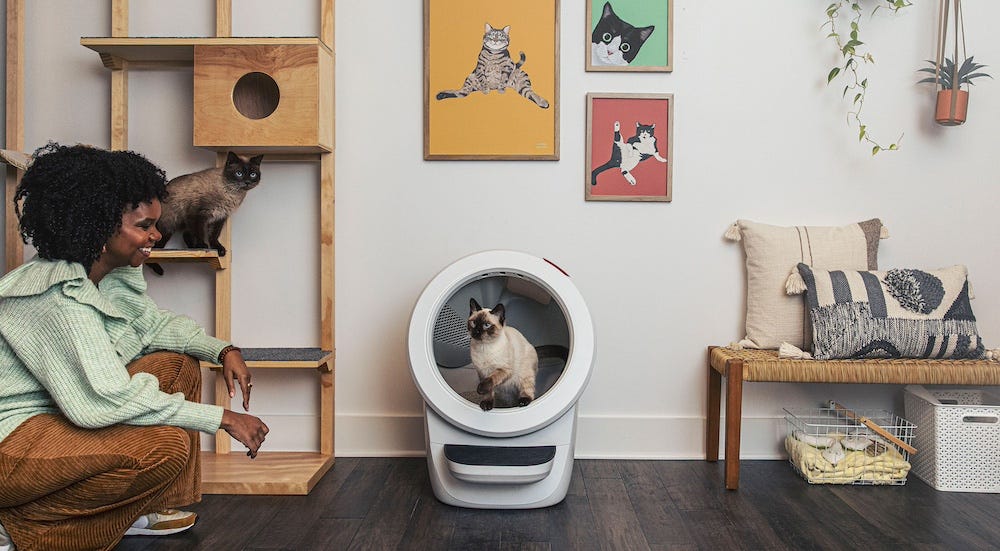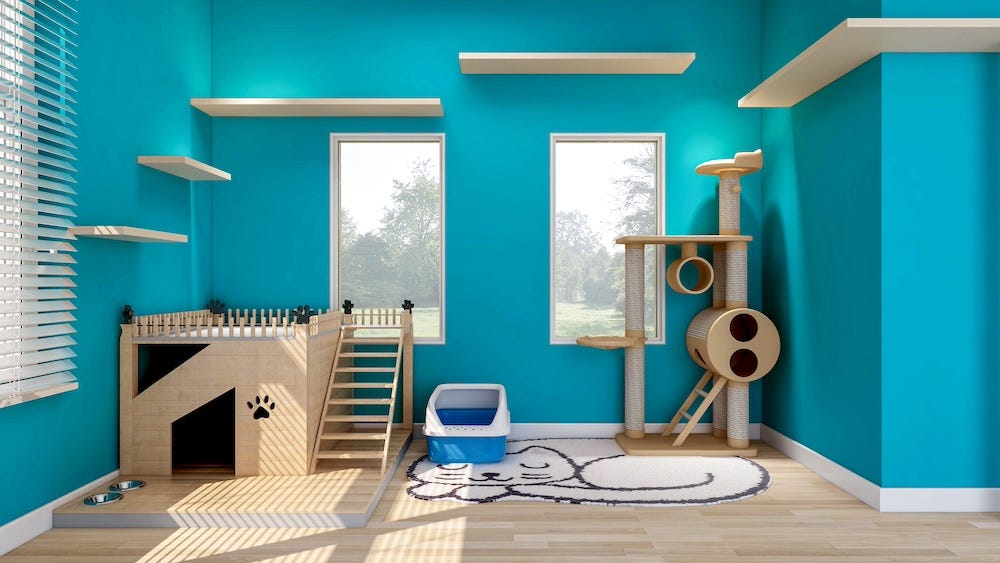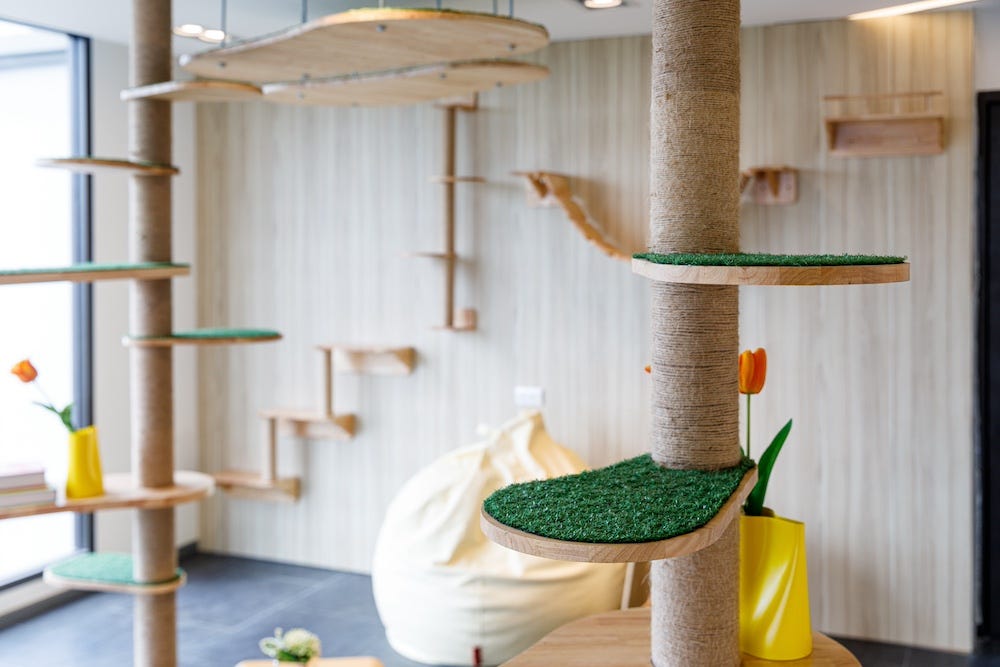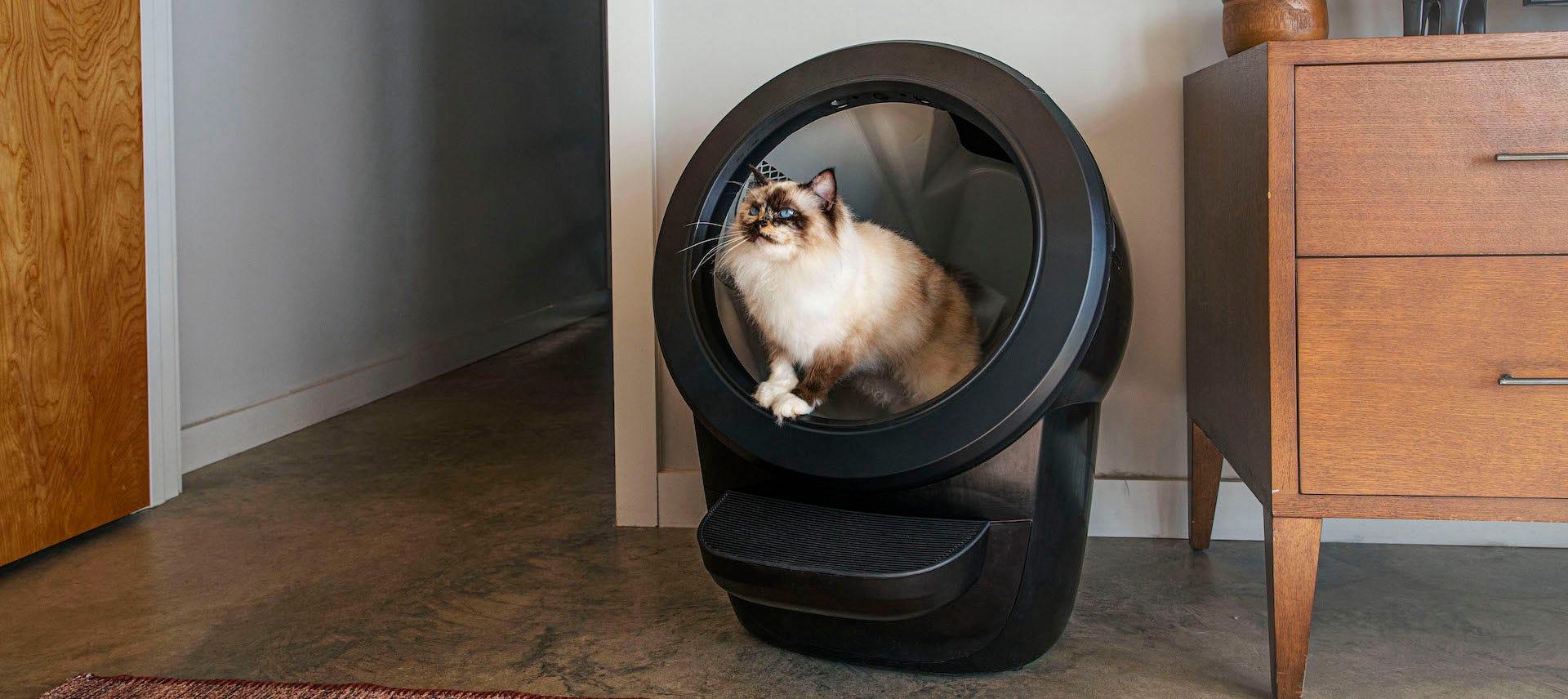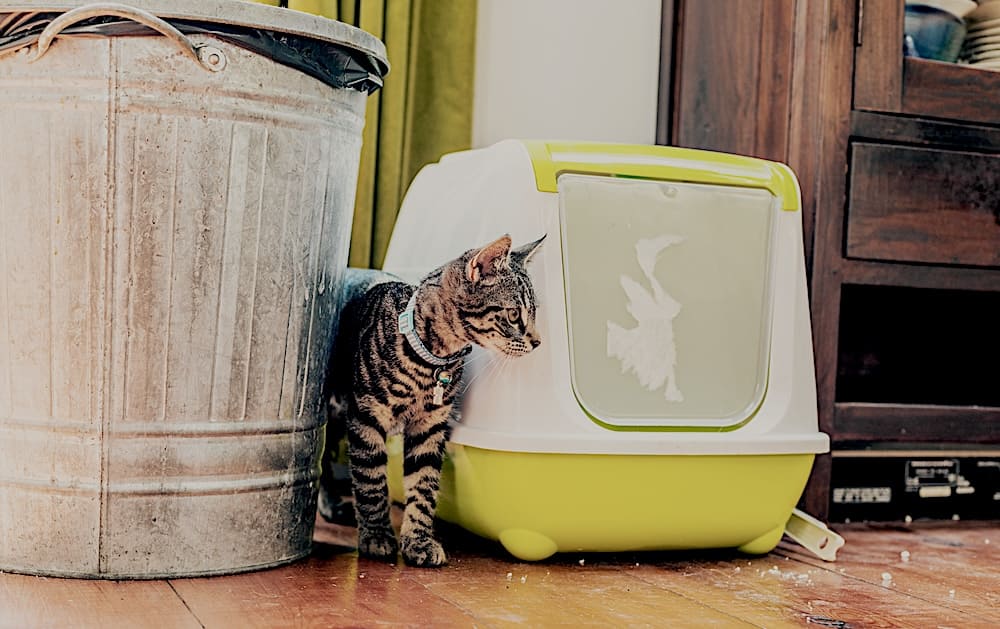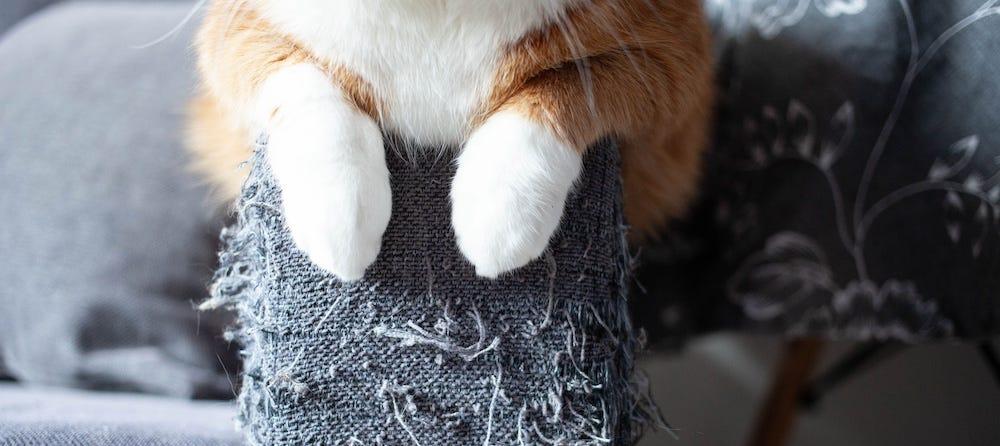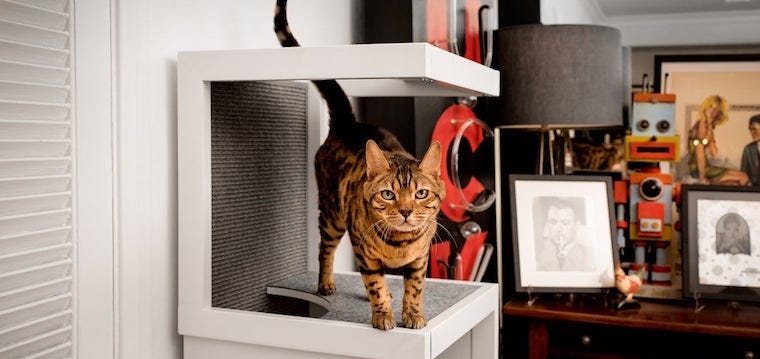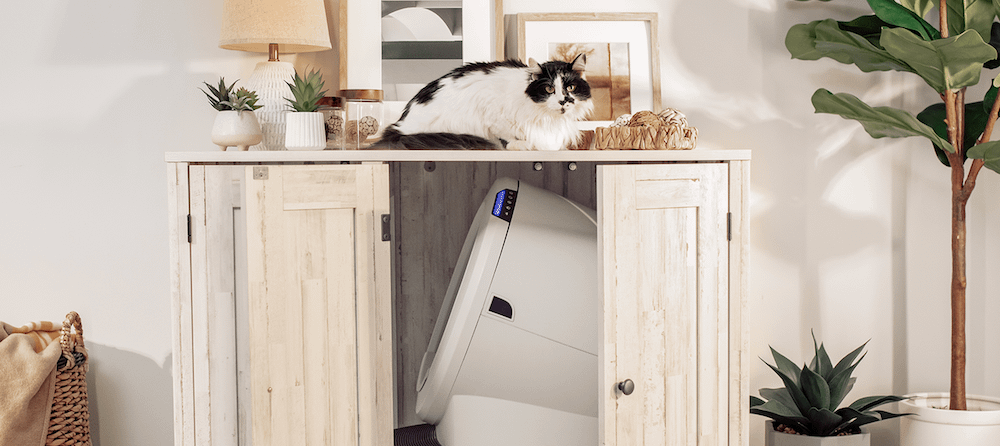In the modern age of pet care, we pet parents are increasingly looking to furnish our homes with our fur babies in mind. Among the many considerations are cat-proof furniture, hidden litter boxes, and cat trees that are functional yet stylish. If you’re seeking advice on cat-friendly decor, look no further than our tips below.
Protecting your decor from cat damage
Afraid to design the living room of your dreams because your cat might destroy the new decor? While scratching furniture and knocking things over is normal for cats, there are ways to redirect these unwanted behaviors.

How to deter cats from damaging decor or furniture
1. Give your cat space to spend their energy
If you give cats their own furniture, they might lose interest in yours. If you have the space, fill a room with cat furniture, toys, and beds where they can expend their energy appropriately. Items to add to this space include cat shelves, perches, and scratching posts.
When considering the best cat shelves and perch alternatives, be sure to choose a sturdy product that can handle the weight of your cat—particularly if your cat is the type to jump from shelf to shelf. Look for wall-mounted shelves with multiple configurations that are easy to install. (Bonus if they include a cushion.) Window perches are a great way to provide your cat with some entertainment, especially if you install a bird feeder outside.
The best cat scratching posts are functional for your cat—and if they’re stylish, all the better.
- Sisal fabric is the most recommended surface material for scratching, but cardboard, wood, and carpet will also do.
- Make sure the scratching post or cat tree is at least as tall as your cat is long, with a sturdy base so it doesn’t fall over when they go to work on it.
2. Use deterrents like scratch guards or anti-scratch sprays
Try to make your furniture “unpleasant” for your cat until they are regularly using their cat scratcher or appropriate cat furniture.
- Add double-sided tape, aluminum foil, or specially designed scratch guard products to spots where you want to deter scratching
- Spray furniture with smells that cats hate, such as citrus, lavender, rosemary, mint, or pine
3. Trim your cat’s claws regularly
Remember, it is perfectly natural for cats to scratch. Do not declaw your cat. Trim your cat’s nails at least once a month to deter unwanted scratching. Make sure to use nail clippers with rounded edges. (Human toe clippers may cause the claw to split.)
Get tips from a veterinarian on how to trim your cat’s claws.
4. Maintain a consistent routine to reduce stress-related scratching
A lack of routine can create stress and even separation anxiety in cats, leading to inappropriate behavior like scratching or spraying on furniture. Here are some tips to reduce your cat’s stress level:
- Ease your cat into any new changes in routine. If you’re going to be out of the house more than usual, gradually increase the time spent outside of the home beforehand. If you’re adopting another cat, keep them separated for several days to weeks while slowly introducing them.
- Provide environmental enrichment for when you’re away from home, such as cat shelves, window perches, and puzzle feeders.
- Take time to bond with your cat every day. Special attention can be paid in a variety of ways, whether it’s grooming, chatting, playing, or simply snuggling.
- Use natural calming pheromones. The veterinarian-recommended product Feliway mimics natural feline pheromones to help stop cats from scratching furniture and urinating inappropriately.
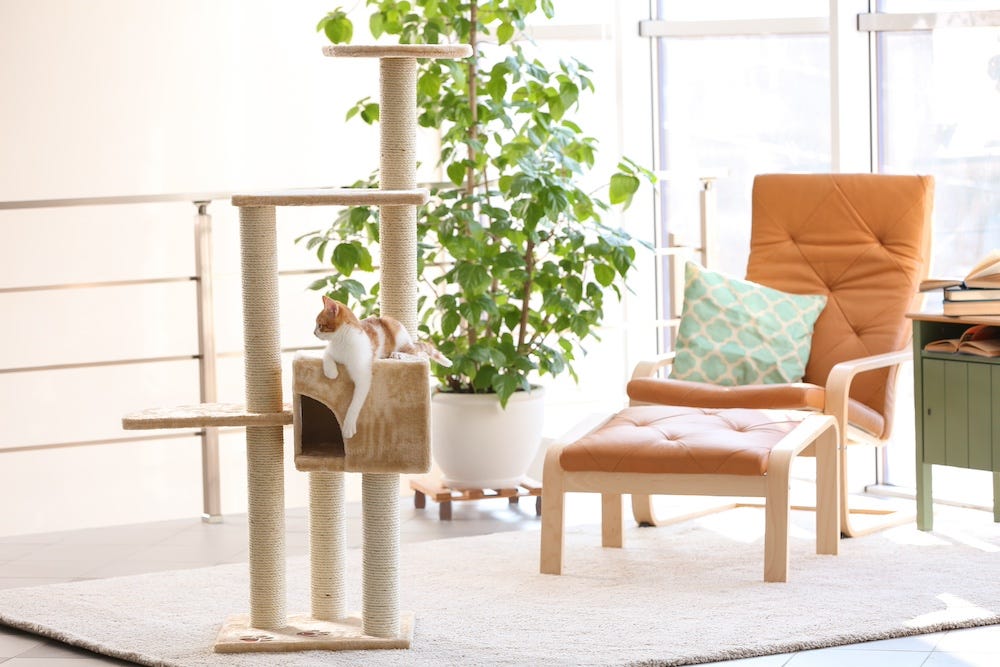
Cat-proof furniture and decor
When choosing cat-friendly furniture, durability, material, and ease of cleaning are key factors to consider.
Durable materials
Opt for couches and chairs made from tightly woven fabrics like microfiber or leather that are easy to clean and resistant to scratches.
You might also select furniture with built-in scratch-resistant features, such as sisal-wrapped legs or designated scratching areas, to help redirect your cat's natural instincts away from your other decor.
Easy to clean
Look for furniture with removable, washable covers to make cleaning up fur and accidental spills easier. Learn more in our guide on cleaning tips for cat parents.
Decor precautions
If your cat likes to knock things over, place your breakable knick-knacks somewhere out of their reach. Choose sturdy decorations that you won’t be sorry to see on the floor from time to time.
Some cats also like to lick or chew plastic, so you’ll want to take inventory and hide or discard any tempting items.
Cat-friendly plants
Cats and plants can co-exist when the right precautions are taken. However, some cats will chew on leaves or pull plants right out of their pots—or use them as a litter box. In that case, you’ll want to hang your houseplants out of reach or place them in a room that your cat has no access to.
Most importantly, choose cat-safe plants. These include, but are not limited to:
- African violets
- Areca palm
- Baby tears
- Boston fern
- Calathea
- Cast iron plant
- Haworthia
- Mosaic plant
- Orchids
- Ponytail palm
- Spider plant
- Swedish ivy
AVOID plants toxic to cats, such as:
- Lilies (many of which are deadly to cats)
- Foxglove
- Philodendron
- Azalea
- Rhododendron
- Cyclamen
- Oleander
- Sago palm, and more
Visit ASPCA’s list of plants that are toxic and non-toxic to cats to learn more.
Litter box placement and concealment
While having a litter box is essential for a feline family, its aesthetics leave much to be desired. And don't even get us started on litter box odors. Finding the right litter box location can be a challenge, especially in a small house or apartment.
The best locations for a litter box
The best location for a litter box is one that your cat prefers. Typically this means somewhere private and quiet with low foot traffic:
- Inside litter box furniture
- Bathroom
- Spare closet
- Guest bedroom
- Laundry or mud room
- Home office
- Corner of a room
- Behind a folding privacy screen
- Underneath a side table or TV console
- Underneath stairs
The worst locations for a litter box include high-traffic areas and children’s play areas, as well as those next to noisy appliances, in direct sunlight, and in close proximity to food and water bowls.
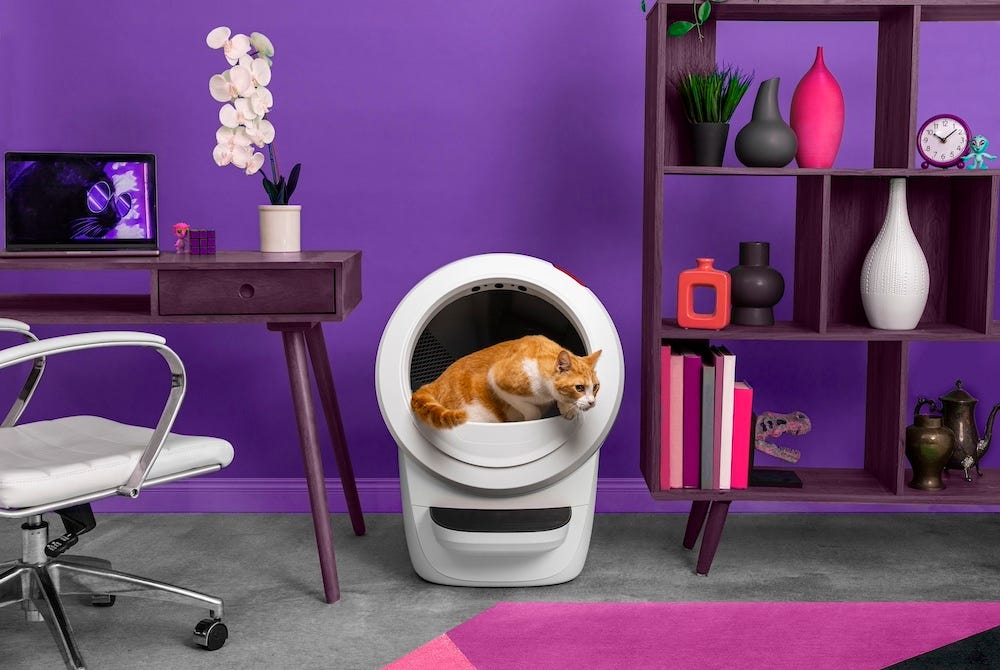
Where to put the litter box in a small house or apartment
If you live in a small house or tiny apartment, it can be hard enough to find space for your own things, let alone the cat's litter box—and it doesn’t exactly constitute attractive cat decor. The goal is to make your limited space work by placing the litter box somewhere that is out of the way, but easy to access.
As mentioned earlier, it is best to choose somewhere calm, quiet, and private. This includes a bathroom, guest bedroom, hallway closet, laundry room, or basement. You can also create a sense of privacy by placing the litter box inside an easily accessible piece of furniture.
If you have multiple cats in a small home, finding space for an appropriate number of litter boxes can get difficult. One option is to invest in a self-cleaning litter box like Litter-Robot 4, which works for up to four cats.
How to hide a litter box
In addition to choosing areas of the home with low foot traffic, you can find creative ways to hide a litter box.
- Tuck away the litter box in the open space beneath a sink or end table. Add curtains or drape stylish fabric for better concealment.
- Liven up a basic litter box cover with a new coat of paint to match your decor. Or, repurpose leftover wallpaper or carpeting samples.
- Convert existing furniture in a litter box cover by fashioning a hole to allow your cat access. Cabinets, wardrobe dressers, and benches are all optimal choices to hold the litter box.
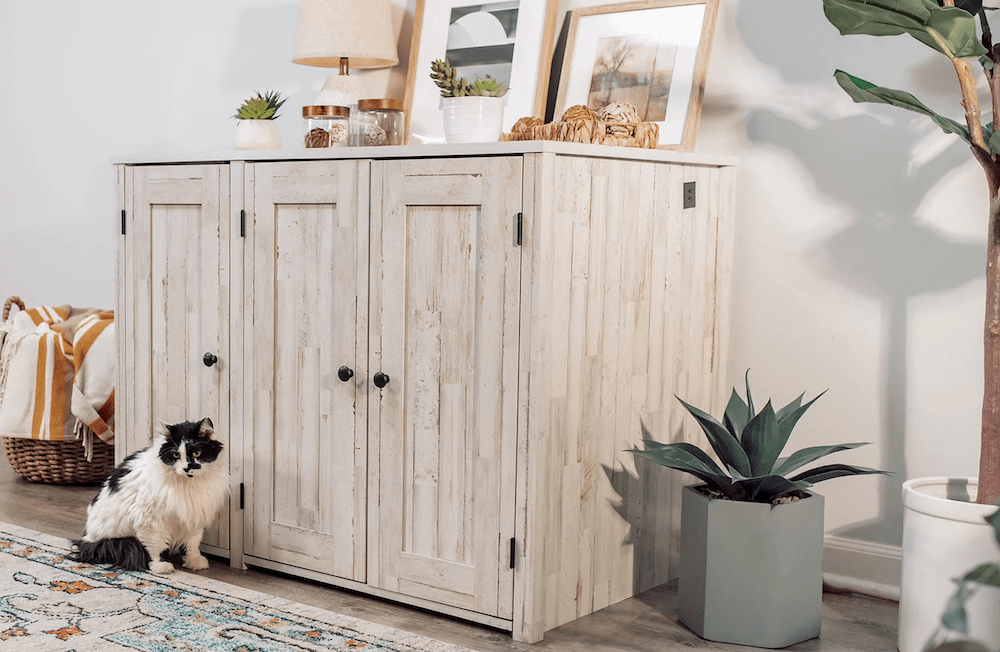
What is the best hidden litter box furniture?
One of the simplest ways to hide a litter box is with litter box furniture. Modern litter box furniture is designed for functionality while blending seamlessly with your home decor. Another plus to having hidden litter box furniture? If you have dogs in the house, this setup will prevent them from having access to stinky litter box “treats.”
Our top choices for hidden litter box furniture include Whisker’s Coastal Credenza and Storage Cabinet. These pieces are expertly designed to conceal your cat’s traditional litter box or Litter-Robot. They’re also multi-functional, providing surface space for supplies, decor, or even a television. Last but not least, these furniture pieces are stylish enough for modern homes.
Fully integrate your cat into your home with cat furniture
The best cat furniture includes features like built-in scratch pads, high-up escapes, comfy nap spots, stylish designs, and space-saving options. Cats need places to play, perch, hide, and rest, which is why a cat tree is the perfect all-in-one option for giving your kitty exactly what they need.
But why settle for an unsightly old-school cat tree when you could have a stylish cat tree alternative?
Modern cat trees and alternatives
Let’s take a closer look at some more of the best qualities in modern cat trees:
- High-quality: A cat tree needs to be durable and sturdy. Your cat will be using it to jump, scratch, and play, so you’ll want to make sure it’s sturdy enough so that it won’t wobble or tip over.
- Cubbies: A great cat tree will have multiple cozy spots for your cat to hang out and nap. Enclosed areas for rest are an added bonus.
- Perches: Perches give your cat the ability to relax and observe from up above. They’ll be able to fulfill their need to climb and have a safe space to decompress.
- Scratch pads: A built-in scratch pad will give your cat a designated area to express their need to scratch while also saving your furniture from being destroyed!
- Multiple levels: These give your kitty a lot of options to jump, climb, and exercise to their heart’s content!
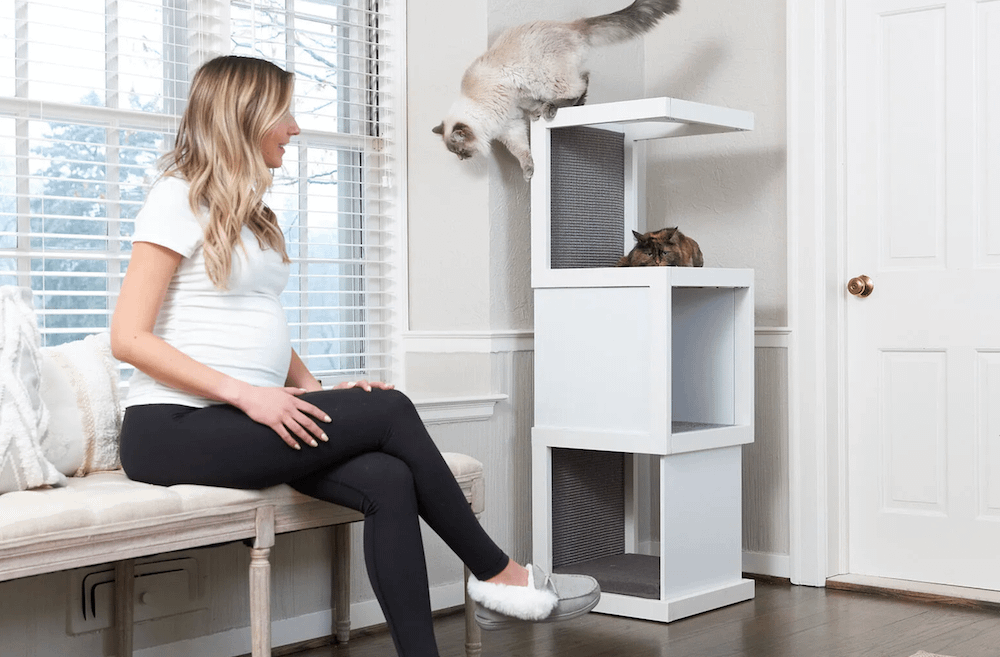
If you’re looking for a cozy piece of cat furniture for your cat to enjoy while ensuring that it matches your desire for something stylish with a modern design, then the Cat Tower by Whisker is exactly what you’re looking for.
The Cat Tower has a cubic design that offers a place to scratch, areas to play, and plenty of spots to nap. Your kitty will be entertained for hours every single day!
Cat trees for large cats
The same qualities apply to cat trees for large cats, but it’s even more important to make sure you get durable furniture that isn’t easy to knock over. The force of climbing, jumping, and clawing may cause low-quality cat furniture to wobble, especially if you have a large cat.
A cat tree with a wide base is ideal for large cats, as they can stretch their full length when relaxing. For example, the Cat Pyramid by Whisker features a base that is 39 inches wide and doubles as a scratch pad. With its A-frame, maze-like structure offering multiple levels, two climbing holes, and soft felt pads, this is a veritable playscape for cats of all sizes.

Cat room ideas
Looking for cat home decor ideas? Here are our must-haves in a cat room:
- Cat furniture – some or all of the following: cat trees, cat shelves, window perches
- Scratching posts
- Cat beds
- Litter box (option to conceal inside litter box furniture or closet, as long as it is easily accessible)
- Food and water (ideally kept separate from the litter box area)
- Cat toys
- Fun cat decor (optional)
- Catio (optional)
Take inspiration from the examples below!
